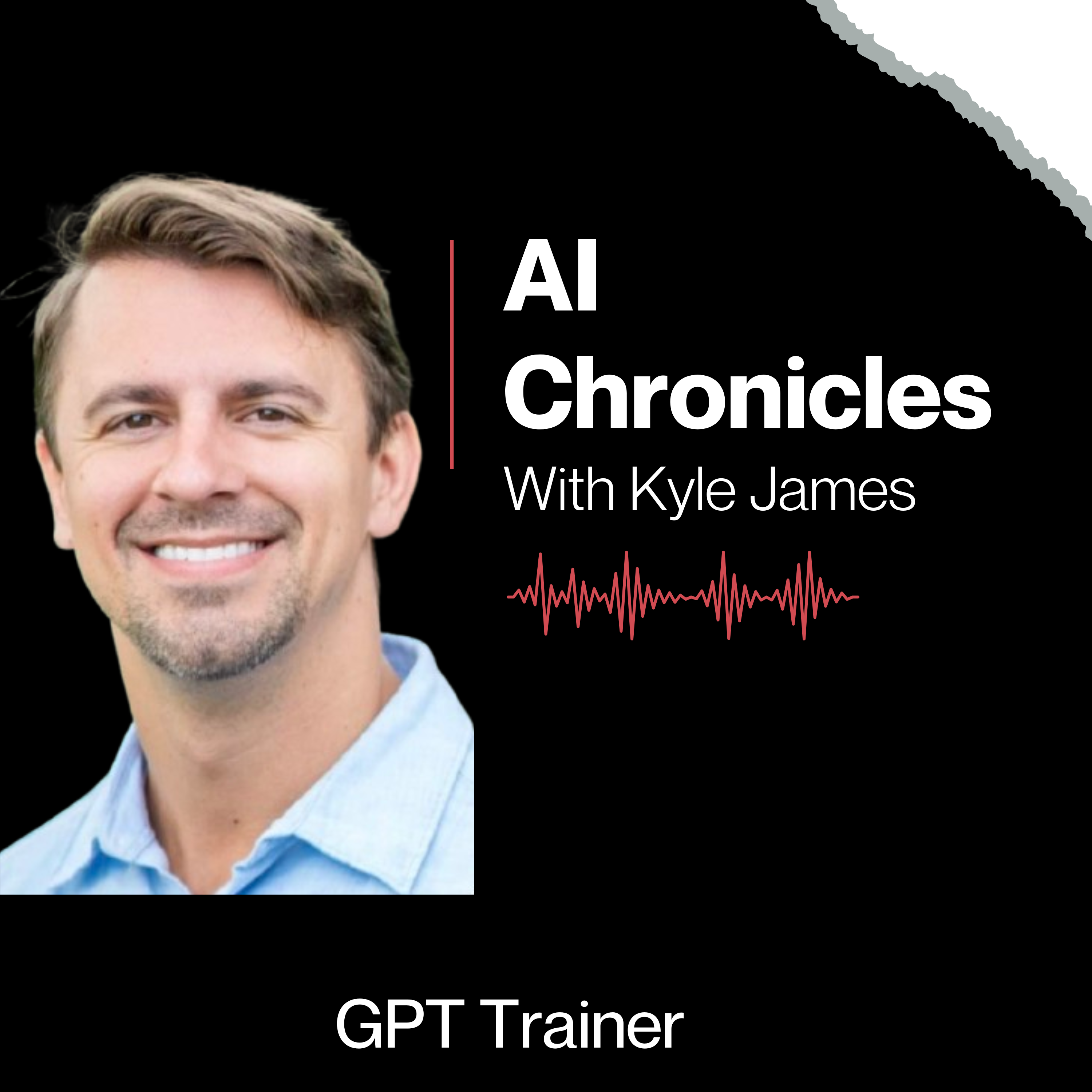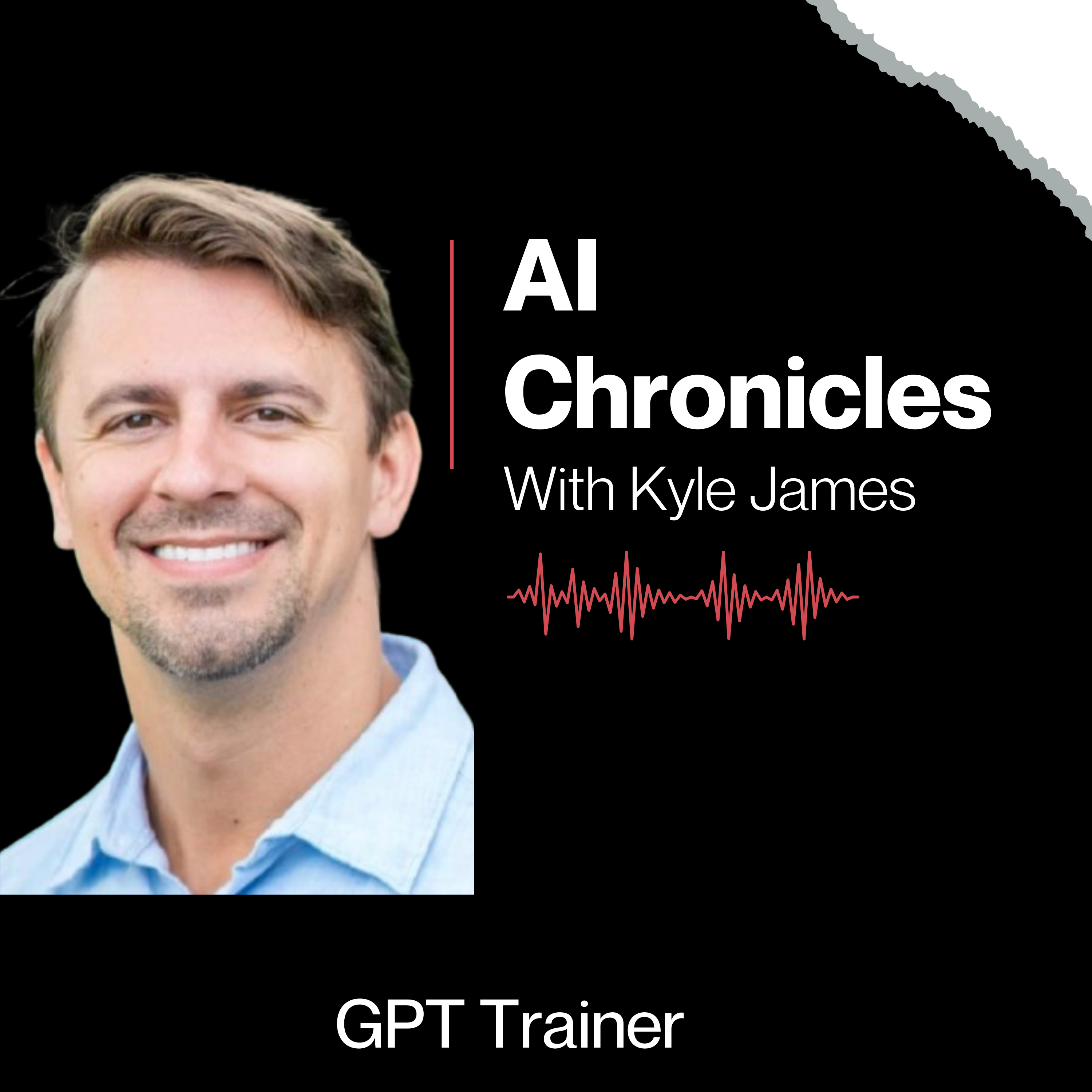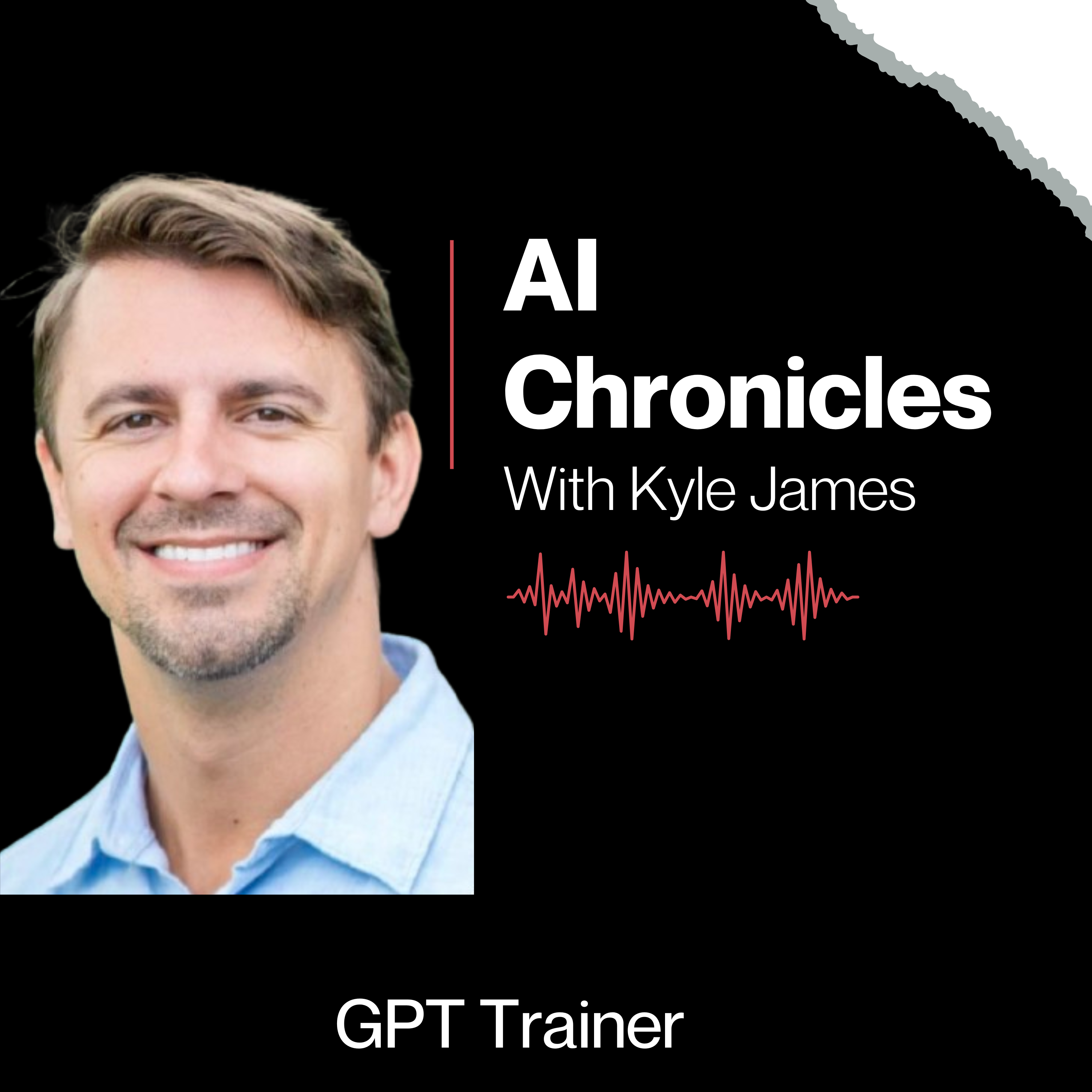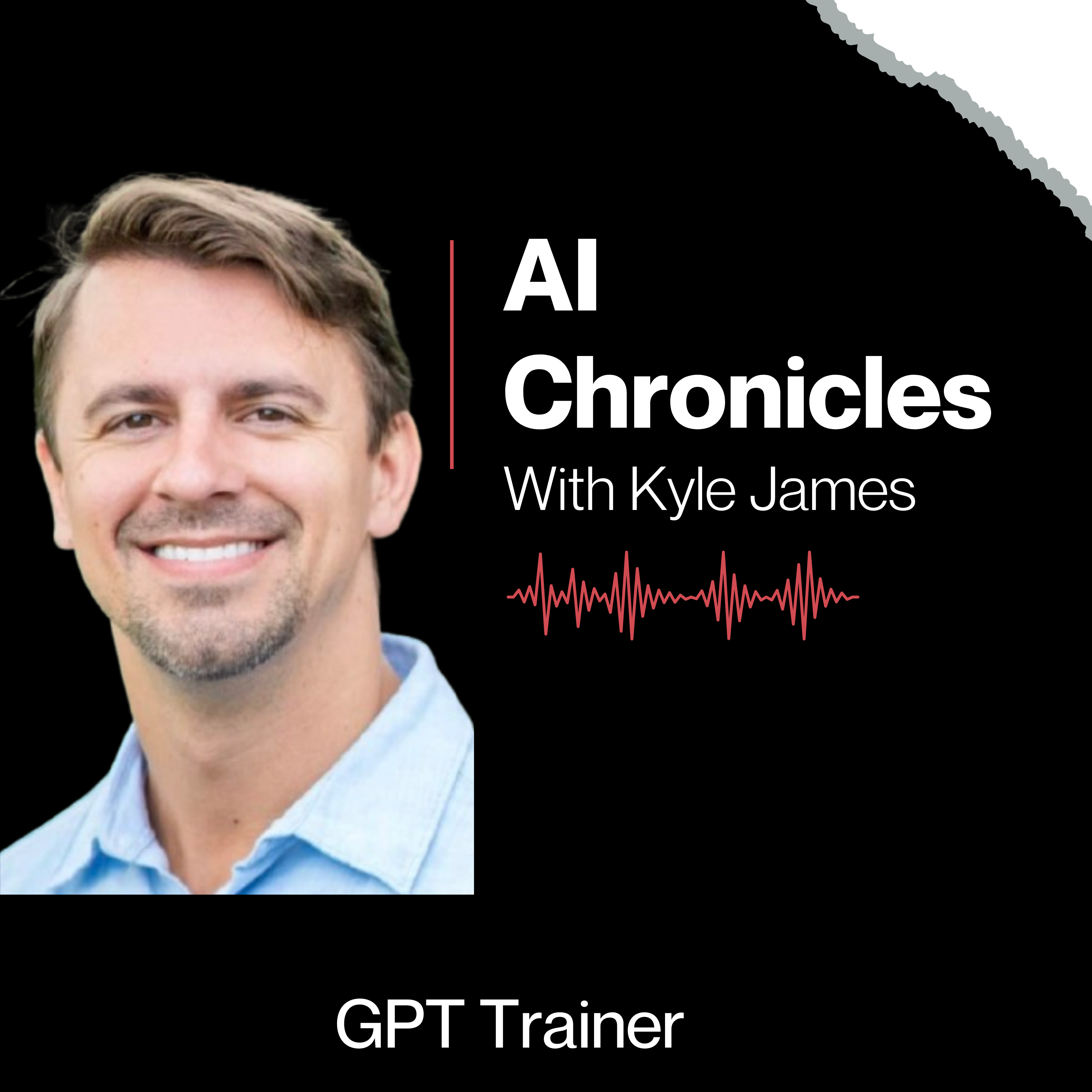Episode Transcript
Kyle James (00:01.388)
Hey, welcome to the ad Chronicles podcast. I'm your host Kyle James. And today we'll be talking about how a digital marketing company called orbit media studios is using AI inside of their own business. And we'll share the exact steps that you can take in order to implement AI for yourself. Now, before we dive into that, listen closely. Are you looking to implement AI inside of your own company or maybe just struggling to get your AI to stop hallucinating? Speak to GPT trainer.
GPT trainer literally builds out and manages your AI for you, eliminating hallucinations for good. Go to gpt-trainer.com. I promise you, it'll be the biggest time saving decision that you've made all year. Trying to set up AI on your own is like trying to build a house from scratch. Sure, you could do it, but the time and frustration is going to take you to get it finished. It may not be worth it. It's a thousand times faster and safer to hire professionals.
scheduled consultation today. Once again, that's gpt-trainer.com. Today, I have with me on the show Andy Crestadena, who is the co-founder and CMO of Orbit Media, a web development and website optimization agency. He's done over 24 years of content marketing, SEO and analytics, and 2.4 years, I love that, of AI. So excited to have Andy on the show. Hey, Andy, welcome in.
Andy Crestodina (01:20.405)
Thanks for having me, Kyle. Looking forward to this.
Kyle James (01:22.55)
Yeah, for sure, man. So tell us a little bit about like, or over at media studios, like how did you find the company? Obviously you got a lot of experience in the SEO and content world. So give us some background there for the audience.
Andy Crestodina (01:32.385)
Sure. January 1st of 2000, I quit the day job. And by April of 2001, it was just me and my co-founder, friend from high school, roommate from college, Barrett. He was already building websites since like the mid-90s. And I was obsessed. I just wanted to combine art and science and make things that were both creative and technical and use both halves of my brain. So right away, I building websites, realized I needed to understand SEO and analytics and conversion.
We didn't call it that, but visitor psychology lead generation. And, once got, once that started to work, we started to attract our own leads instead of just being an outsourced agency to, to, other companies and grew organically ever since I've never bought an ad. This is one of those many brands that have grown totally on content and inbound strategies. So 24 years later, we're a team of 53. We built a lot of high performing B2B lead gen sites for companies with big expectations for inbound leads and.
This is an AI of course is, I mean, we're in the bullseye for a lot of the job titles and categories where there's AI opportunity. So I, when this came along, I just knew I had to like invest a lot of time in research and experimentation and learning. so yeah, I speak at lots of, I give AI presentations sometimes twice a day. I teach at the, I teach workshops at an, AI at lot of conferences. I'm speaking at AI conferences. So.
just to completely, you know, dedicated myself to learning as much as I could about this, as your audience, I'm sure is kind of, focused on as well. And yeah, happy to share all my favorite use cases and methods and dos and don'ts. This should be fun.
Kyle James (03:14.51)
Yeah. Yeah. So talking a little bit about, mean, 24 years in the business, like you've seen kind of before AI and then obviously post AI, like what would you say is kind of like maybe the biggest, biggest change since AI has been introduced into this world of marketing?
Andy Crestodina (03:29.761)
Sure. Well, as an SEO, there's just disruption. Like, SEOs are really freaked out about the drop in organic click-through rates. But that's been going on since long before AI. People also ask box. In Featured Snip, it's in Knowledge Panels. And the Video Carousel have reduced click-through rates. AI Overview is just like another nail in that coffin. It's rough. I have no from my data and my clients' data. I have access to like 500 analytics accounts.
is that that's mostly affecting information intent queries, people looking for answers and content programs, traffic to and click through rates to websites for the commercial intent queries, people looking to research an option, research a partner. Those are much, much less disrupted. So that's one of the big changes. Workflow changes, of course. There's infinite use cases for AI. And so I do a lot of teaching and speaking on topics for like
Using AI to improve conversion rates, maximizing the percentage of visitors who become leads. Using AI to research target audiences and better understand and like do data-driven empathy. AI to rank higher in traditional search. AI to be discovered in AI responses in the LLMs themselves. So there's at least four big topics. And so it can be a bit overwhelming, but this is a time of opportunity if you've got the right attitude.
Kyle James (04:50.476)
Yeah, for sure. you, I mean, obviously speaking a lot of different engagements so far and like what, has been kind of like, just on the AI front, right? Like what's been kind of the most, I don't know if it's like types of questions that you're getting a lot from people or maybe concerns, like what are, some of those key things are like, man, I've noticed that people are leaning towards this, right? I noticed they're asking a lot about this in the AI space. What would you say that that particular thing might be?
Andy Crestodina (05:14.209)
accuracy, GPT trainer you mentioned, like, you know, you can include some nations, but a lot of people are just worried about it. do an annual survey of a thousand marketers and I've got maybe 200 responses right now. And you can see the biggest concerns are, accuracy and sort of just like lack of originality. I address that in my use cases by simply using it to do performance analysis and audits. And the way I teach it, it's like first train AI on your target audience, because before you've done that.
You don't, you your target, your content's not really targeted. Teach it the target and then it's targeted. and then once you have that persona, you can give it things like full page screenshots of your homepage or your key pages or your landing pages or proposals or anything, and just ask it what's missing. In other words, I don't, I'm not very interested in using AI to find efficiencies. I'm very, very interested in using AI to find deficiencies, find gaps, persona driven gap analysis, because
There's already people on your website right now, like as we speak, right? They're flowing through your pages. What questions haven't you answered? What objections did you leave unaddressed? Which marketing claims did you make that were unsupported with evidence, testimonials, data, case studies, logos? These are amazing ways to use AI that completely avoid any concern about accuracy because you're just getting a point of view. Go through it, decide what makes sense, disregard 80 % of it if it's not useful to you. But that is...
AI for driving outcomes. it's a different perspective, I think, than people expect to hear. But that's been the most useful use of AI so far for me.
Kyle James (06:52.108)
Yeah. So it's almost like, like in this case, like training the first starting off, right? Cause I think a lot of people are using chat, GBT and other large language models. But in this case, it's like, Hey, train it on your business specifically, like train it on your ICP, trade it on your marketing message, your offers, like train it all on that. And then from there, like it can give a little bit more of a targeted approach to one, your business, but even like taking that same concept and applying it to your customers and your clients that you're working with. Because obviously if you do, if your business, then you can do it for.
Other businesses too, as far as like, like specifically though, I mean, that's one example, like what specific challenges, like, you find yourself trying to solve for a lot of your clients today and like, and how does AI fit in that in between that?
Andy Crestodina (07:22.315)
Sure. Yeah.
Andy Crestodina (07:38.401)
Yeah, I think a lot of people haven't yet figured out that AI is in fact a better way to write prompts than writing them by hand. So where I used to just say, you know, you're a content strategist and you your, your job is to improve the quality of this piece of content. wrote a content best practices include these 11 things, whatever these 10 things or six things. They have good internal linking. They, they are highly structured with subheads. have visuals at every scroll depth. They have a personal point of view and I'd write a prompt.
Now I find that it's far more useful to just say, AI, your goal is to write a reusable prompt that audits content for best practices. Here are content best practices. And then it writes a prompt that's way better than I would have made myself. Like it's structured. gives like sections that I wouldn't have done. And it's got like tables. so that is a fantastic way to use AI and becomes a big unlock. beyond that, I think a lot of people haven't yet realized just how much you can give it, like just upload things to it.
get a point of view from it and use that to produce a better deliverable, whatever that might be. These are things that I think are how people move up the learning curve. When the emotions in the market are changed from disruption to opportunity, the more you know, the better your skills are with these tools, the more effective you become at using them, the more this era just stays more as a...
The more exciting things are, the less stressful things are.
Kyle James (09:06.798)
Yeah, for sure. For sure. And like with the kind of like in your process and this could be like both internally kind of like your own team, but even like externally with a lot of your clients are working with, like what's that step-by-step process that, um, either on the AI front or even just like working with them, like utilizing AI, like what have you seen and what's that process look like?
Andy Crestodina (09:26.495)
Because they have infinite use cases, think some of the people who are the best at this just simply break down their normal workflow. So I saw a slide at an event when someone said just put a Post-it note on your screen that says, could AI help me with this? So workflows have multiple steps. So let's say I'm building a high-performing page. What does that involve? Well, I need to understand the target audience. OK, we do that with stakeholder interviews. Step two, I need to construct an outline that roughly
aligns with their prioritized information needs. Great. Step three, I need to make sure all these claims are supported by evidence. So each of these steps in a workflow, that was a quick example, have AI prompts and methods that can help with that. The next thing you realize is once you have like strong, effective, tested, reasonable prompts, you can then combine those into an automation, a Gemini Gem, a Cloud Project or a custom GPT in OpenAI.
custom GPT, and that becomes a tool where like, you suddenly realize like, I just sort of made software, like I built a system, this can be shared. We just got forever smarter and more, more effective. So those are things that, if you, you go from standard operating procedures to one shot prompts, to reusable prompts, to automations, and then from automations one day, like these will probably evolve into agents and we'll all end up being AI bosses over.
you know, both humans and agents and each one, you know, is doing a different job.
Kyle James (10:57.006)
Yeah, I almost like see, just literally picture the scene in the world. Like every person is a manager. Now we are, we're just managing much AI and having them work like a bunch of like ants running around an ant bed. That's, that's pretty.
Andy Crestodina (11:03.361)
Mm-hmm.
Andy Crestodina (11:07.649)
Check their work. Did they do a good job? Do you need different inputs? Hey, I need this output in a different format. And you need to work with that other agent now. So how do I connect you to?
Kyle James (11:17.71)
Yeah, even like you think like the manufacturing business, right? Like all the machines, like that's kind of what humans have been like in a sense is doing is like, they're just, they're just overseeing these massive machines and making sure they're working. And then if there's any issues and they can repair and fix them control if they need to. It's like almost like no differently here. AI is kind of the same concept. It's a machine, just more of an intelligence and we manage it as humans. Hopefully it's just us managing it.
Andy Crestodina (11:38.721)
percent.
Kyle James (11:40.366)
So what types of like results would you say you've been seeing so far since like both implementing AI internally and then maybe externally that's, you know, maybe worth mentioning that you think is valuable.
Andy Crestodina (11:52.427)
Sure. Well, it's a big topic, and it's a bit uncertain yet. But I am tracking traffic from AI to my website. There's gaps in that. But I build GA4 reports that show me what traffic came from which model to which landing page. Any improvement to any page to fill gaps and answer questions, address objections, these are reflected in your key event rate in Google Analytics, although I still call it just the conversion rate. There are use cases that will do things for you that really are impossible for a human to do.
Like once you have a persona, you can ask AI like, what is the most important thing that my target audience doesn't know? A human can't really get that from a stakeholder interview. Or what are the most important topics in my industry that are never covered by the big blogs? A human can't really do that. You can't read every article. So there again, gap analysis. So it can improve your content strategy. It can improve engagement in social media when you find those interesting, provocative topics, conversion rates on websites.
Click through rates on calls to action. have a prompt that audits called CTAs. It can improve email signup rates and grow your list by writing better email signup CTAs and newsletter subscriber boxes. So all of these are about results. I'm not really measuring time savings in AI. I know there's people who say like, this will unlock infinite time. I get that. I think that comes later. If you focus on performance,
and you create reasonable prompts and automations, in the end, you'll have huge efficiency. I sometimes generate two personas at the same time, like on two different screens. Like a human couldn't do that. But the specific measurable outcomes are in the context of the use case and the goal of using AI in that minute.
Kyle James (13:36.918)
Yeah, for sure. You talk, you mentioned one thing, you mentioned it kind of towards the beginning of the podcast here. You talked about the gaps, identify gaps. think there's like a lot of like people who are like, okay, how do I make it better? Right. How do I make my process better? My system's better. But in this case, you're like, Hey, let's look at the gaps. Like, why do you feel like it's like identifying the gaps is, is more important than say, like, you know, getting better. Because I think a lot of companies are like, Hey, what do I, what do I spend my time? Like,
How are they going to get the best ROI that you would suggest like by focusing on the gaps versus maybe the other side of it?
Andy Crestodina (14:11.019)
Yeah, well, in a web, in a user's experience on a website, on a page, the likelihood of that person taking action, clicking the CTA and becoming a lead is largely a function of whether or not that page was satisfying to them. If, there any unanswered questions, whether it was it, did you skip something? Did you miss something? I've never seen a page that didn't have huge opportunities. I did one this morning. It's like, this, the buyer is like a job site project manager, project engineer for construction.
They need to see certifications. They need to see that you have ongoing support. Like this was like for a contract, like a manufacturer, like HVAC or something. This page will work harder without generating any more, without more traffic, just by making sure that that page is satisfying to the visitor and meets their needs. The job of the digital marketer on key service pages for lead generation and in content for engagement and audience growth is all about satisfying information needs.
So it's very, very hard for a human brain to spot what's missing. You know, it's like, just look around the room and say, what's not here. Like a brain's don't really work that way. So gap analysis also effective for internal processes. can give it your email drip sequence and say, what's the most important email not here. You can give it a social post and say, you know, where did I miss any opportunities to trigger emotion or intrigue or curiosity? Whatever it is you made your sales deck, your, your, know,
your keyword strategy, your marketing strategy, whatever it is, even a single prompt. How could you make this a better prompt? it's just, whatever it is, it just becomes this amazing Swiss army knife for improving any single thing, public or internal. Why wouldn't you do that? I think that is really the moment when some marketers are really going to pull ahead because they just changed their thinking a little bit.
Kyle James (16:02.542)
Yeah, I think that's such a great strategy though is like, mean, because I think we're all using it at this point, but like we all take kind of different approaches and angles as to like how we're using the AI in this case, like, love how you're like, Hey, identify these gaps. Like what am I, what am I missing? I got to know what I have. Like, what am I missing? That's maybe a key element. Cause like that, feel like those hidden gaps that are in there, like that can be a, turns into be like a big, a big barrier in the long run, because you're like, wait, why, didn't the campaign go well?
Hey, you're missing a key element here that needs to be in there. think that's a really cool strategy that your team are doing, Andy. And as we transition here, what, what do you feel like, especially stepping into these next couple of years, so much has changed, so much changes happen, but what some of those upcoming AI initiatives and like, where do you see AI playing maybe the biggest role in your operations next?
Andy Crestodina (16:50.433)
Well, I find that one of the things that I'm noticing is that the exports from a lot of my tools are not giving me structured data. And that's pretty frustrating. So I have this amazing way to find interesting correlations between LinkedIn activity and outcomes. Which are the topics when you talk about them on LinkedIn grow your following? Which ones create comments and which ones cause these certain outcomes? If you export your data from LinkedIn and upload it to AI, it'll tell you.
But to do that, you have to really spend like, I'm not kidding. spent nine, it took me 90 minutes to turn this output from LinkedIn into a structured data CSV file and to manually tag all the topics and all that stuff. So that's a big difference. And that, that I hope will improve because whatever tool you use, if it's got an export button, you've got an analysis opportunity, but the, might need to have this intermediate step where you, I think best just manually clean up data. Another one is, are marketers going to all start building their own
custom GPTs and automations. I want, that's one of my big questions and I'm not sure, but it's looking like, yes, a lot of people are quickly spinning up automations. I encourage everyone to experiment. That's what, that's the time we're living in right now, but test, run these things side by side, like use it, be critical, don't trust it. So, you know, they say English is the hot new programming language. Just like programmers build, you know, write code that need to be
debugged, anyone doing prompts needs to run that prompt side by side with the first draft of it and just see if you're making it better. So I'm very critical of AI. And I always go back and tell it to keep improving because lots of times the first shot really didn't get me where I wanted to go.
Kyle James (18:38.222)
Yeah, absolutely. Now I appreciate, appreciate your perspective on that Andy. And as we start wrapping this up, this conversation, like where can people go maybe to learn a little bit more about you and then maybe a little bit more about orbit media studios that you'd recommend.
Andy Crestodina (18:51.489)
Well, my best social network is LinkedIn. LinkedIn is emerged as kind of you know, the best place for business and networking and content. So Andy Crestadena on LinkedIn, can, if you, there's a blue follow button. If you find the contact or the connect button and just mentioned that you heard me here, I'm happy to accept them. can chat then. orbitmedia.com is the website. Looking at that, you'll get a sense for the, you know,
the ways in which pages fill gaps and support their claims of evidence. But also the Orbit Media blog is where I publish first. I've written one article there every two weeks since 2007. And a lot of my new articles are filled with prompts and AI use cases.
Kyle James (19:34.51)
Well, awesome. Love it so much. Thanks so much, Annie. It's great having you on the show today and definitely keep in touch. Hopefully have a get on the show in the future and have another good time, I would say. And again, thanks for everybody for listening in. Remember, if you're looking to implement AI into your business today, please don't try and do it yourself. The time is just the AI could cause it may not be worth it. Schedule a call with GPT trainer. Let them build out and manage your AI for you. Once again, that's GPT-trainer.com.
Andy Crestodina (19:44.597)
Thanks, Kyle.
Kyle James (20:01.26)
Signing off for now, thanks so much everybody for listening in. Looking forward to seeing everyone on the next episode of AI Chronicles.



